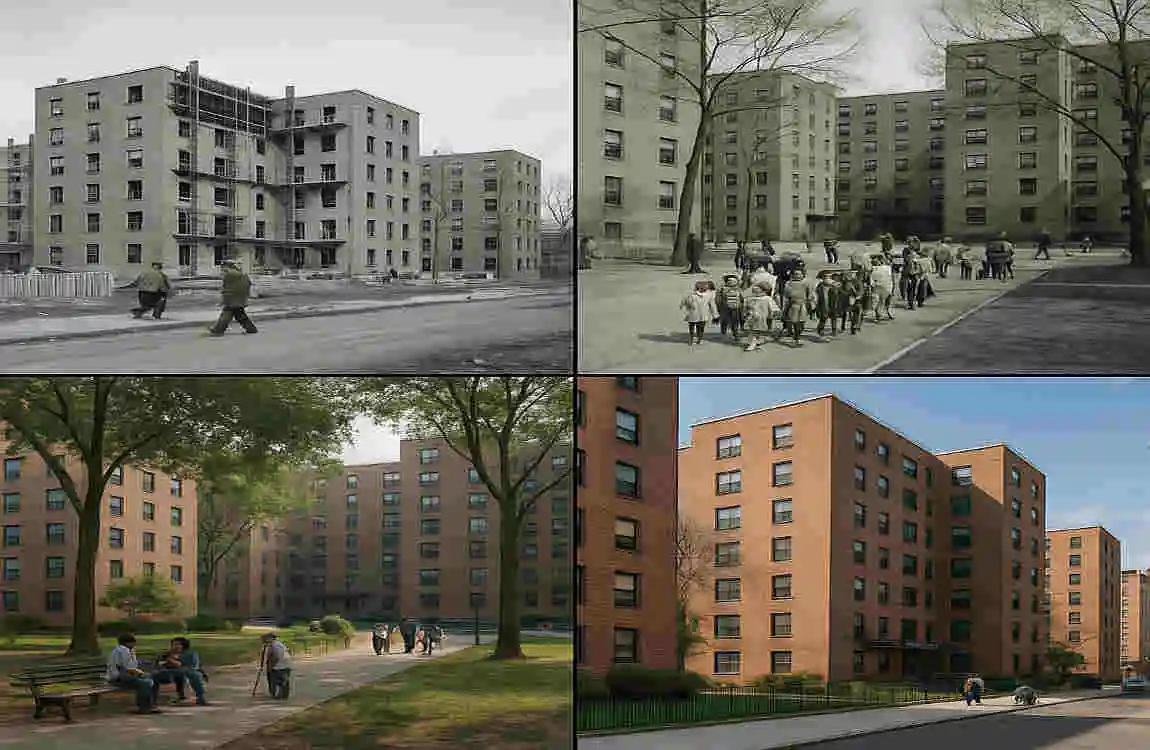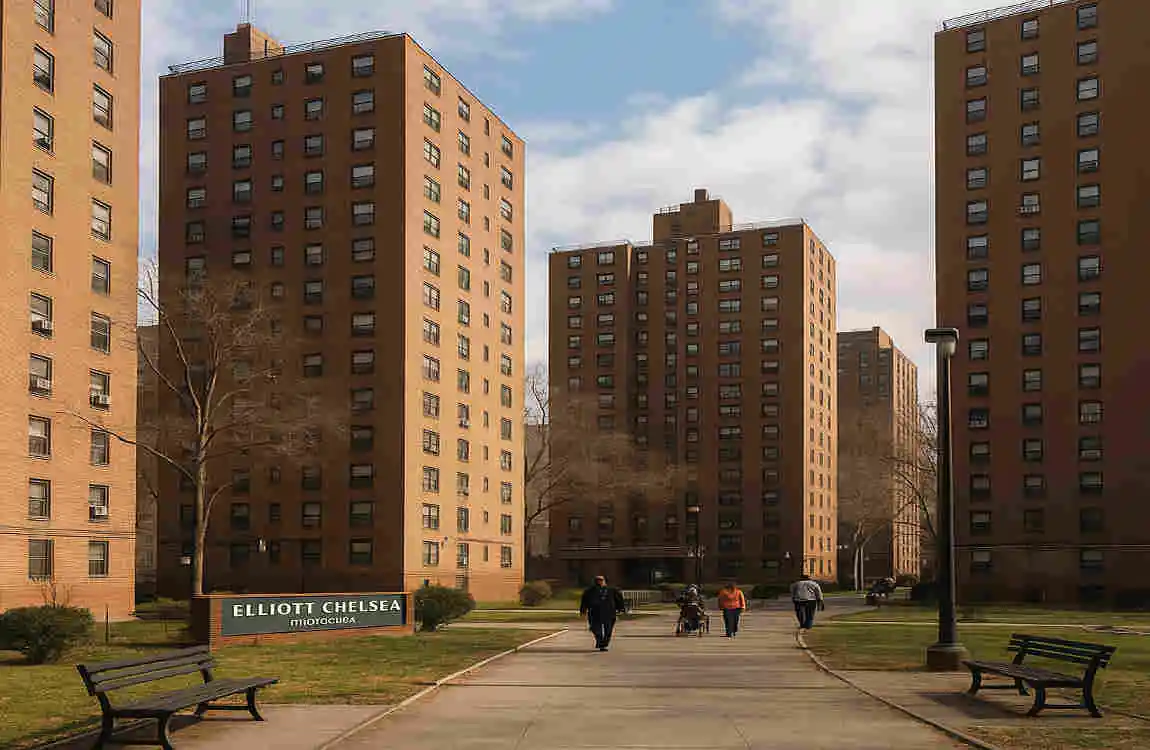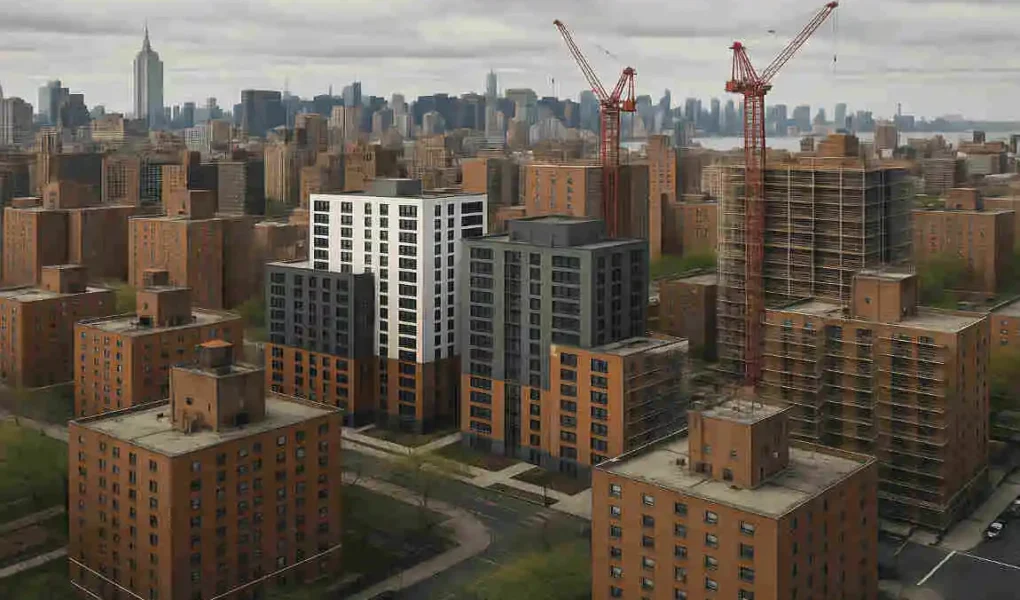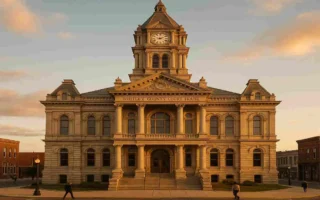Hey there! Let’s talk about something that’s shaping the future of New York City’s public housing landscape: the Elliott-Chelsea Houses NYC. If you’ve walked through Chelsea in Manhattan, you might have noticed these towering buildings that have stood as a home for thousands of New Yorkers for decades. But did you know they’re undergoing a massive transformation right now? This isn’t just a facelift—it’s a complete overhaul, sparking hope, debate, and a whole lot of questions.
Public housing in NYC isn’t just about bricks and mortar; it’s about community, history, and providing a safety net for those who need it most. The Elliott Houses NYC, together with the nearby Chelsea Houses, represent a piece of that story. Today, I’m delving into their past, their current challenges, and the ambitious redevelopment plan that’s set to redefine affordable living in one of the city’s priciest neighbourhoods. Please stick with me as we explore what this project means for residents, the city, and the future of public housing. Let’s get started!
History of Elliott Houses NYC

The Birth of Elliott Houses
Let’s take a step back to the 1940s when the Elliott Houses in NYC first came to life. Groundbreaking began in 1945, and by 1947, these buildings were ready to welcome families. Named after John Lovejoy Elliott, a social reformer and founder of the Hudson Guild, this project was part of a broader push to provide decent housing for low-income New Yorkers after World War II. Can you imagine the hope these homes represented at the time? A fresh start for so many.
You may also read (how to understand drafting in home architecture).
Architectural Innovation
What made Elliott Houses stand out was their design. Architect William Lescaze, a pioneer of modern architecture, brought a “tower in the park” style to the project. Picture this: tall buildings surrounded by open green spaces, a stark contrast to the cramped tenements of the era. This was revolutionary for public housing at the time, aiming to give residents light, air, and a sense of community. Pretty forward-thinking.
Evolution Over the Decades
Over the years, the Elliott Houses became a cornerstone of Chelsea. But time hasn’t always been kind. The buildings, originally housing hundreds of families across 12 structures, faced wear and tear. Maintenance lagged, and what was once innovative began to feel outdated. Still, the location—smack in the heart of Chelsea—made this land incredibly valuable, which brings us to some early criticisms.
Early Criticisms and Land Value
Even in the early days, some questioned whether such prime real estate should be dedicated to public housing. Chelsea was undergoing a transformation, and the land under the Elliott Houses in NYC became a highly sought-after commodity. Critics argued it could be used for more lucrative developments, but supporters fought hard to keep it a haven for working-class families. This tension—between affordability and profit—has followed the site for decades. What do you think: should prime land always stay accessible to everyone?
Overview of Chelsea Houses

A Later Addition to the Neighbourhood
Fast forward to the early 1960s, and the Chelsea Houses entered the scene. Built between 1961 and 1964, these 14 buildings added more affordable units blocks away from Elliott Houses. While they share a similar mission, their story is a bit different. Have you ever noticed the close relationship between these two developments? They’re practically neighbours!
Architect Paul L. Wood’s Vision
The Chelsea Houses were designed by Paul L. Wood, who took inspiration from the same “tower in the park” concept but adapted it to the needs of the time. His goal? Create functional, no-frills housing that prioritizes space and community. These buildings weren’t flashy, but they got the job done, providing homes for thousands during a period of rapid urban growth in NYC.
State Funding and Community Impact
Unlike some other projects, Chelsea Houses benefited from state funding, which helped get them off the ground. Once completed, they became a lifeline for families in need, fostering a tight-knit community. Local schools, shops, and services grew around them, weaving these buildings into the fabric of Chelsea. It’s amazing how much a housing project can shape a neighbourhood.
A Combined Identity
Here’s where it gets interesting: over time, the Elliott Houses and Chelsea Houses were combined for administrative purposes under the New York City Housing Authority (NYCHA). Together, they’re often referred to as the Elliott-Chelsea Houses, housing over 5,000 residents across 26 buildings. This merger made sense for management, but it also tied their futures together—a fact that’s particularly relevant as we discuss the rebuild.
Current State of Elliott-Chelsea Houses

Who Lives Here?
Today, the Elliott-Chelsea Houses are home to a diverse group of New Yorkers. From young families to seniors who’ve lived there for decades, the community reflects the city’s melting pot. Many residents are low-income, relying on public housing to keep a roof over their heads in a neighbourhood where rents are extremely high. Imagine trying to afford a home in Chelsea on a tight budget without these homes!
You may also read (what makes billy grahams montreat house a historic landmark).
Buildings in Decline
But let’s be real: the buildings themselves are struggling. Decades of underfunding have left them in rough shape. Think leaking roofs, broken elevators, and outdated plumbing. Residents have dealt with these issues for years, and it’s not just inconvenient—it’s a quality-of-life problem. Have you ever had to deal with a home that’s falling apart? It’s frustrating, to put it mildly.
Why a Rebuild Is Needed
The infrastructure challenges are huge. NYCHA faces a massive capital deficit city-wide, and Elliott-Chelsea is no exception. Repairs alone will no longer suffice; the buildings require a complete overhaul. That’s where the current rebuild project comes in. It’s not just about fixing what’s broken—it’s about reimagining what public housing can be. Sounds exciting, but also a bit daunting, right?
The Rebuild Project: A Historic Transformation
A Bold Announcement
In 2023, NYCHA unveiled a game-changing plan for the Elliott Houses NYC and Chelsea Houses: a full redevelopment set to wrap up by 2025 (though timelines can shift). The goal? Tear down the ageing structures and build anew. This isn’t a small patch-up job; it’s a $1.9 billion project that’s grabbing headlines. What would you do with a chance to start fresh like this?
A New Vision for Housing
Here’s the big idea: replace the current 2,056 NYCHA apartments with 3,500 mixed-income units. That means some apartments will stay affordable for low-income families, while others will be market-rate to help fund the project. It’s a balancing act—balancing the spirit of public housing with the need to make the numbers work. Developers like Related Companies and Essence Development are leading the charge, and they’ve got big plans.
The Design Dream Team
Speaking of plans, the design and planning team is stacked with talent. Firms like PAU, COOKFOX Architects, and ILA are working to create a modern, livable space. They’re focusing on sustainability, safety, and community needs. Imagine buildings that aren’t just functional but actually inspire. That’s the vision here. Are you curious about what the new designs will look like?
Construction Timeline and Phases
The project is rolling out in phases. Demolition of some buildings has already begun, with the construction of new units following closely behind. Relocating residents during this process presents a significant logistical challenge; however, the plan aims to minimize disruption. The full timeline spans several years, with different sections of the site being addressed one at a time. It’s a slow but steady approach—kind of like rebuilding a puzzle piece by piece.
Financing the Future
Now, let’s talk money. At $1.9 billion, this isn’t a cheap endeavour. Funding is sourced from a combination of public and private sources, including federal programs and developer investments. The mixed-income model plays a big role here—market-rate units help offset costs. However, with such a hefty price tag, every dollar must be accounted for. Do you think this type of investment in public housing is worthwhile?
Resident Involvement and Impact
Having a Say in the Future
One of the most notable aspects of this project is the involvement of residents. In June 2023, they voted on the redevelopment plan, giving a thumbs-up to move forward. This wasn’t just a formality—NYCHA’s PACT (Permanent Affordability Commitment Together) program ensures tenants have a voice. How empowering is that? Imagine getting to help shape where you live!
Protections and Promises
Under the PACT program, residents are guaranteed certain protections. For one, their rent won’t skyrocket—they’ll pay what they can afford, just like before. Plus, anyone displaced during construction has a “right to return” to the new development. It’s a significant promise, and NYCHA is working diligently to fulfil it. Still, change is never easy.
Relocation Challenges
Speaking of displacement, relocation is a hot topic. Some residents, especially seniors, have received orders to vacate as demolition begins. NYCHA is arranging temporary housing, but it’s a tough pill to swallow for folks who’ve called Elliott-Chelsea home for decades. Community groups are stepping in to support, but concerns linger. How would you feel about packing up and moving, even if it’s temporary?
Senior Residents and Community Concerns
Seniors, in particular, are feeling the strain. Many worry about losing their community ties or struggling with the logistics of relocation. Tenant advocates have raised concerns about vacate orders, advocating for greater transparency and support. It’s a reminder that behind every policy and plan, there are real people with real emotions. Let’s keep them in mind as we talk about progress.
Features of the New Development
Modern Living at Its Best
So, what’s in store for the new Elliott-Chelsea Houses? Think modern apartments with updated amenities—things like energy-efficient appliances, better heating, and accessible layouts. After years of dealing with rundown conditions, residents deserve a home that feels fresh and functional. Wouldn’t you love a space that’s both practical and comfortable?
Affordable and Market-Rate Mix
The new development will include permanently affordable units alongside market-rate ones. This mix is crucial for funding the project while ensuring that low-income families aren’t pushed out. It’s a delicate balance, though—too many high-end units, and the community’s character could change. What’s your take on blending different income levels in one space?
Community Spaces and More
Beyond housing, the plan includes new community facilities, retail spots, and public spaces. Imagine a community centre with events, shops on the ground floor, and green areas for relaxation. These additions aim to make Elliott-Chelsea a true neighbourhood hub, not just a place to sleep. Sounds like a win.
Safety and Sustainability
Safety and sustainability are also at the forefront. The new designs focus on secure buildings equipped with modern systems to prevent issues such as flooding or power outages. Additionally, eco-friendly features will reduce energy consumption. It’s all about building for the future—both for people and the planet. How important do you think “green” design is in projects like this?
The Broader Context: NYCHA’s Public Housing Revitalisation
A City-Wide Strategy
The Elliott-Chelsea rebuild isn’t happening in a vacuum. It’s part of NYCHA’s broader push to revitalize public housing across NYC. With hundreds of thousands of units in need of repair, the agency is seeking innovative ways to fund and repair its properties. Elliott-Chelsea could be a blueprint for what’s next. Pretty significant.
Funding and Oversight
Money is always the big question. NYCHA relies on federal funding, but it’s often not enough. That’s why public-private partnerships, such as the one driving this project, are becoming increasingly common. Federal oversight ensures the money is spent wisely, but it also adds layers of complexity. Do you think private companies should play such a big role in public housing?
A Model for the Future?
If successful, the Elliott-Chelsea project could inspire similar rebuilds across the city. It’s a test case for the mixed-income model and resident involvement. However, success isn’t guaranteed—there are numerous hurdles to overcome. Still, the potential to transform lives and neighbourhoods is huge. What lessons do you think other cities could learn from this?
Challenges and Controversies
Pushback from Tenants
Not everyone is in favour of the rebuild. Some tenant groups and leaders have voiced opposition, worried about losing control over their homes. Recent tenant leadership elections highlighted these tensions, with debates over whether demolition is the right path. It’s a valid concern—changing this big is scary. Have you ever been part of a community facing upheaval like this?
Gentrification Fears
Then there’s the “G” word: gentrification. With market-rate units coming in, some fear Chelsea will become even less affordable, pushing out longtime residents. The mixed-income model aims to prevent this, but scepticism remains. Balancing affordability with development costs is tricky, especially in a neighbourhood as desirable as Chelsea. What’s more important to you—preserving a community or modernizing it?
Neighborhood Changes
Beyond housing, the rebuild could reshape the entire area. New retail and public spaces might attract wealthier residents or businesses, altering Chelsea’s vibe. For some, this is progress; for others, it’s a loss of identity. It’s a debate with no easy answers. How do you think cities should handle growth without losing their soul?
Future Outlook
When Will It Be Done?
The Elliott-Chelsea rebuild is being undertaken on a phased timeline, with full completion expected within the coming years. Different sections will finish at other times, allowing residents to move back gradually. It’s a lengthy process, but the ultimate goal is worth it: a revitalized community for current and future generations. Can you picture what Chelsea will look like when it’s done?
Long-Term Benefits
Once complete, the benefits could be huge. Better living conditions, stronger community spaces, and a model for sustainable public housing are all on the table. For residents, it means a safer, more comfortable home. For NYC, it’s a step toward addressing the housing crisis. Doesn’t that sound like a win-win?
Shaping Policy and Urban Growth
Looking further ahead, this project might influence NYC’s approach to public housing and urban development. If it works, we could see more rebuilds with similar funding and design strategies. It’s an opportunity to reassess how cities support their most vulnerable residents. What kind of housing future do you hope to see in your town?
Conclusion
Let’s wrap this up by reflecting on the journey of the Elliott Houses NYC and the Chelsea Houses. From their historic beginnings in the mid-20th century to the transformative rebuild underway now, these homes have always been more than just buildings—they’re a symbol of community and resilience. This $1.9 billion project isn’t just about new apartments; it’s about renewal, hope, and preserving affordable housing in a city that desperately needs it.
I’ve walked you through the history, the challenges, and the exciting possibilities ahead. But this story isn’t over—it’s unfolding right now. I encourage you to stay informed, support public housing initiatives, and consider lending your voice to residents navigating this change. Together, we can ensure projects like Elliott-Chelsea prioritize people over profit. What do you think the future holds for public housing in NYC? Drop your thoughts below—I’d love to hear them!
You may also read (historic whitley county courthouse icon of columbia citys heritage).




